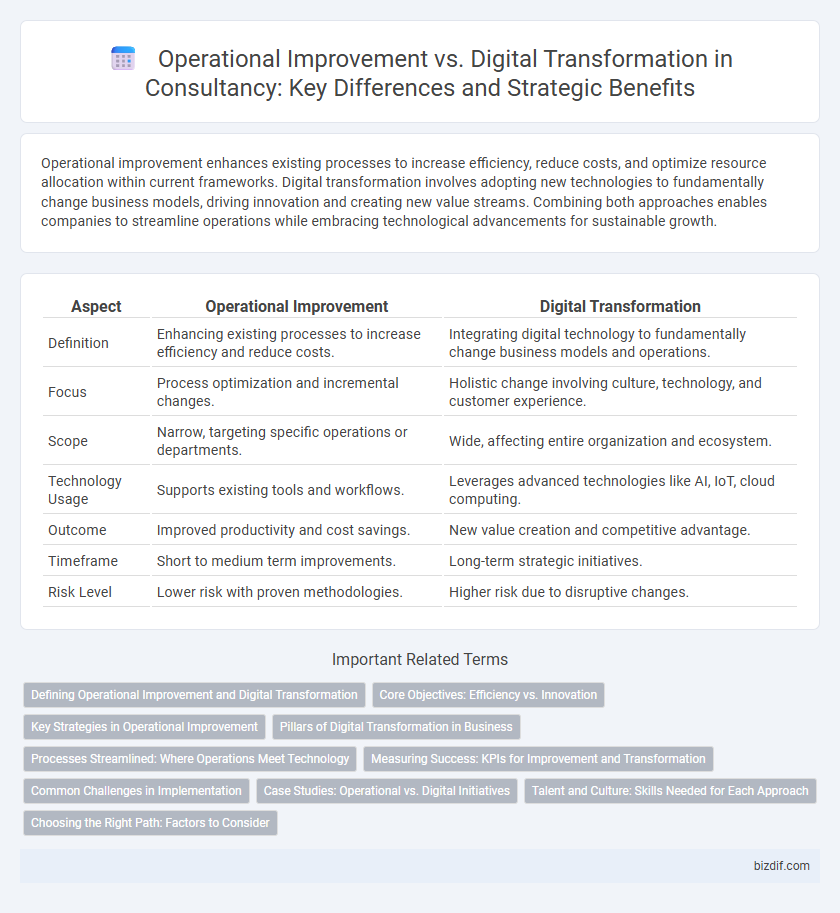Operational improvement enhances existing processes to increase efficiency, reduce costs, and optimize resource allocation within current frameworks. Digital transformation involves adopting new technologies to fundamentally change business models, driving innovation and creating new value streams. Combining both approaches enables companies to streamline operations while embracing technological advancements for sustainable growth.
Table of Comparison
| Aspect | Operational Improvement | Digital Transformation |
|---|---|---|
| Definition | Enhancing existing processes to increase efficiency and reduce costs. | Integrating digital technology to fundamentally change business models and operations. |
| Focus | Process optimization and incremental changes. | Holistic change involving culture, technology, and customer experience. |
| Scope | Narrow, targeting specific operations or departments. | Wide, affecting entire organization and ecosystem. |
| Technology Usage | Supports existing tools and workflows. | Leverages advanced technologies like AI, IoT, cloud computing. |
| Outcome | Improved productivity and cost savings. | New value creation and competitive advantage. |
| Timeframe | Short to medium term improvements. | Long-term strategic initiatives. |
| Risk Level | Lower risk with proven methodologies. | Higher risk due to disruptive changes. |
Defining Operational Improvement and Digital Transformation
Operational improvement focuses on enhancing existing business processes, increasing efficiency, and reducing costs through incremental changes. Digital transformation involves integrating advanced digital technologies across all areas of a business to fundamentally change how organizations operate and deliver value to customers. Both strategies aim to boost performance but differ in scope, with operational improvement targeting process optimization and digital transformation driving cultural and technological shifts.
Core Objectives: Efficiency vs. Innovation
Operational improvement targets enhancing efficiency by streamlining processes, reducing costs, and minimizing waste to maximize current performance. Digital transformation prioritizes innovation through integrating advanced technologies, fostering agility, and creating new business models to drive competitive advantage. Balancing efficiency and innovation is crucial for sustainable growth and long-term organizational success.
Key Strategies in Operational Improvement
Key strategies in operational improvement prioritize lean process optimization, waste reduction, and enhanced workflow efficiency to boost productivity and reduce costs. Emphasizing data-driven decision-making and continuous performance monitoring ensures sustained operational excellence. Unlike digital transformation's broad technology adoption, operational improvement targets immediate, measurable gains through structured process management and employee engagement.
Pillars of Digital Transformation in Business
Operational improvement focuses on streamlining processes, enhancing efficiency, and reducing costs through incremental changes, whereas digital transformation involves a holistic integration of advanced technologies such as AI, cloud computing, and IoT to redefine business models and customer experiences. The pillars of digital transformation in business include customer experience, operational agility, culture and leadership, workforce enablement, and digital technology integration. Emphasizing these pillars drives innovation, accelerates decision-making, and creates sustainable competitive advantages in the digital economy.
Processes Streamlined: Where Operations Meet Technology
Operational improvement focuses on refining existing processes to increase efficiency and reduce costs, often through incremental changes and lean methodologies. Digital transformation integrates advanced technologies such as automation, AI, and data analytics to fundamentally reshape business processes for agility and innovation. Combining streamlined operations with cutting-edge technology bridges the gap between traditional efficiency and future-ready capabilities, driving sustained competitive advantage.
Measuring Success: KPIs for Improvement and Transformation
Operational improvement success is measured through KPIs such as production efficiency, cost reduction, and cycle time, emphasizing incremental gains in existing workflows. Digital transformation KPIs focus on innovation metrics like digital adoption rates, customer engagement through digital channels, and revenue growth from new digital products or services. Combining both approaches requires balanced measurement frameworks to track short-term operational gains alongside long-term digital maturity and business model evolution.
Common Challenges in Implementation
Operational improvement often faces challenges such as resistance to process changes, lack of clear performance metrics, and insufficient employee training, which can hinder efficiency gains. Digital transformation struggles with complex technology integration, data security concerns, and cultural shifts required for adopting new digital tools. Both initiatives require robust change management strategies, leadership commitment, and continuous measurement to overcome common implementation barriers effectively.
Case Studies: Operational vs. Digital Initiatives
Case studies comparing operational improvement and digital transformation initiatives reveal that operational projects often achieve immediate efficiency gains by optimizing existing processes, reducing costs, and enhancing workflow. Digital transformation case studies highlight long-term business model innovation, leveraging technologies such as AI, cloud computing, and IoT to drive customer experience and data-driven decision-making. Companies that integrate both approaches see synergistic effects, combining streamlined operations with cutting-edge digital capabilities for sustained competitive advantage.
Talent and Culture: Skills Needed for Each Approach
Operational improvement demands skills in process optimization, change management, and lean methodologies to enhance efficiency and reduce costs within existing frameworks. Digital transformation requires advanced capabilities in data analytics, digital literacy, agile project management, and innovation-driven mindset to integrate new technologies and drive cultural shifts. Talent development strategies should align with these skill sets to ensure effective execution and sustained organizational growth.
Choosing the Right Path: Factors to Consider
Operational improvement focuses on enhancing existing processes for efficiency and cost reduction, while digital transformation involves integrating advanced technologies to fundamentally change business models. Evaluating organizational readiness, budget constraints, and long-term strategic goals helps determine which path aligns best with company objectives. Prioritizing stakeholder engagement and scalability ensures sustainable impact whether optimizing operations or embracing digital innovation.
Operational improvement vs Digital transformation Infographic

 bizdif.com
bizdif.com